Solar Power Plant – A Short Guide
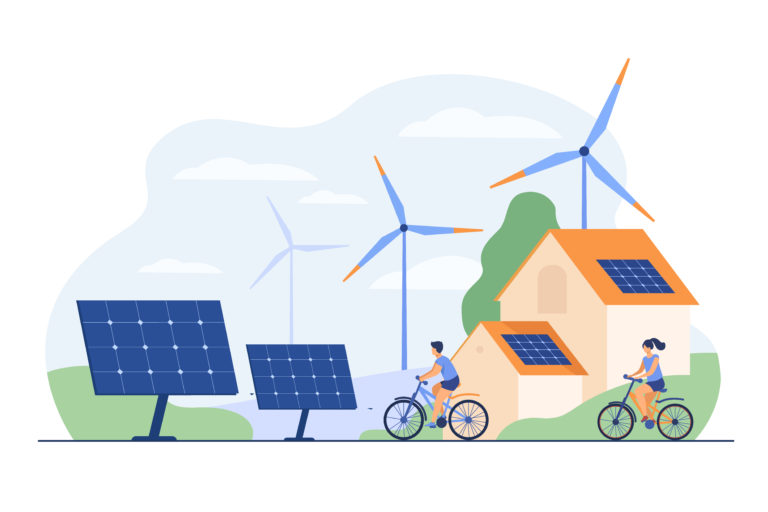
What is a Solar Power Plant?
A solar plant is a type of installation that transforms sunlight directly, like photovoltaics, or indirectly into electricity such as solar thermal plants. They come in a range of ways, using discreetly different strategies to make use of the intensity of the light.
In this article, we will examine the various types of solar plants which use energy from the Sun to generate electricity.
PV Solar Plant
Sunlight is converted to usable energy using vast photovoltaic fields, called photovoltaic panels or solar panels. These cells are generally made of silicone alloys and are the technology most people know – you might even have one on the roof.
The panels themselves are available in different forms:
- The crystalline solar panels are constructed from crystalline silicone, as the name implies. They may be monoscriptal or polycrystalline (also called multi-crystalline). The thumb version is in general Monocrystalline more effective (approximately 20% or higher) but more costly than its alternative (which tends to be 15-17% efficient) but progress closes the gap with time.
- Solar panels with thin film: these panels are composed of a series of film, which absorb light in various sections of the EM spectrum. It is typically made of amorphous silicon (a-Si), cadmium telluride (CdTe), sulfide (CdS), and diselenide copper indium (gallium). This panel style is perfect for applications as flexible films on existing surfaces or for the incorporation into construction materials such as roofing tiles.
These kinds of solar panels produce electricity, which is then normally fed directly to or deposited in batteries in the national grid.
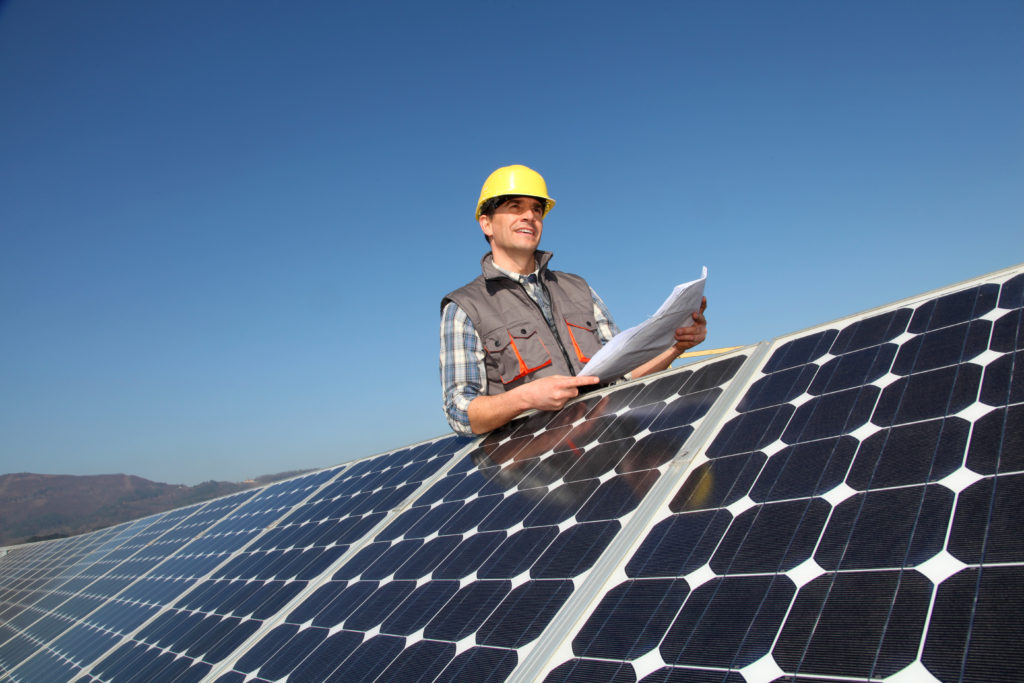
The following basic components appear to be used for power plants using these types of panels:
- Sunlight is converted into usable energy by solar panels. The generation of DC current is usually up to 1500V voltages.
- These installations require inverters to convert the DC into AC.
- Typically, you have some sort of a system for controlling the plant and handling it.
- Sometimes they are linked directly to a certain external grid.
- Typically, step-up transformers are used if the plant produces more than 500 kW.
What is the Functioning of a Solar PV Plant?
Solar photovoltaic power plants run in the same fashion as household panels. Most solar panels, as we have seen, are made of half-conducting materials, typically some kind of silicone. When the semiconductor material is hit by sunlight, free electrons are generated which can then be transported through the material to create a direct electric current.
The photoelectric effect is also known. In order for the DC current to be directly used or supplied into the electrical grid, an inverter must then transform it to an alternative current (AC).
PV panels are different from other solar plants because they directly use the photo effect without the need for other processes or equipment. As with solar thermal plants, for example, they don’t use a fluid thermal carrier, like water. PV panels do not focus energy, only transform photons and transmit them into electricity somewhere else.
Solar Thermal Power Plant
Solar thermal power plants, on the contrary, concentrate or capture sunlight in such a way that steam is produced and powered by a turbine. Three other distinct kinds of solar thermal plants can also be separated:
- Linear
- Parabolic through Solar Thermal
- Solar Dish Power Plants
The most popular types of a solar power plant are the use of fields from either linear collector, parabola or solar plates. These types of installations are generally made up of a wide ‘field’ of parallel solar collectors.
They are typically three distinct systems.
Parabolic Systems
Parabolic troughs are equipped with parabolic reflectors, which can concentrate the collector on normal sunlight at anywhere 30-100 times. The process is used to heat a fluid, which is then stored in a central position to produce superheated high-pressure steam.
The devices want to keep track of the sun all day long. Solar Energy Generation Systems (SEGS), one of these types of power plants, is the world’s longest running solar thermal plant in the Mojave Desert of California. In 1984 was installed the first factory, SEGS 1. The last SEGS IX power plant with 92-Megawatt (MW) capacity started operations in 1990. SEGS IX was installed. Nine SEGS operating plants are currently installed at the site with a combined capacity of approximately 354 MW net (gross 394 MW) – making it a worldwide major thermal power solar energy project.
Such solar thermal power plants work by focuses solar light on receiver tubes which run the mirror length at their focal point from long parabola mirrors. This intense solar power heats up a fluid that flows through the tubes continuously. This heated fluid is then sent to a heat exchanger to boil water to produce power from a traditional steam turbine generator.
Linear Concentrating Systems
Linear concentrations systems, called reflectors often Fresnel, also consist of large “sheets” of sun-tracking mirrors, which are orientated north-south in an effort to maximize the capture of sunlight. This arrangement allows the mirror sides to watch the sun all day from east to west. Linear focusing systems absorb solar energy with long, rectangular U-shaped mirrors like their parable mirror cousins. In comparison to parabola, however, linear reflector systems from Fresnel place the reception tube over the mirrors, giving the mirrors greater tracking mobility in the light.
The Fresnel lens effect is used with these types of systems to use a large focusing mirror with a big opening and short focal length. This set-up helps the sun to focus about 30 times the usual strength of this type of system.
Solar Engines & Solar Dishes
Solar plates use mirrors to concentrate the energy of the sun on a collector. They appear to consist of plates such as large satellite plates, which are covered with a mosaic of small mirrors focusing energy on a recipient at the focus. The dish-shaped, mirrored surface focuses and concentrates sunlight on a thermal recipient at the focusing point of the dish like the parabolic and linear systems. The heat produced by this receiver is then transferred to an engine generator. A Stirling engine type is the most common type of heat engine in plaster/engine systems. Heated fluid is used by the plate recipient to transfer pistons on the motor to generate mechanical power.
This mechanical power is then used to produce electricity by a generator or alternator. Solar power plates/engines often directly point to the sun and focus solar energy at the center of the plug. A solar dish is much higher than a linear concentration system and has a working fluid temperature above 749°C. Either power generating equipment can be directly installed (excellent for remote locations) in the dish’s concentrate or can be collected in a range of plates and electric generation at the core.
At the Tooele Army Depot, Utah, the U.S. army now uses 429 Stirling solar plates to build a 1.5MW battery.
Solar Towers
Solar towers are a fascinating means of reflecting and focusing solar energy on a central tower in hundreds to thousands of flat sun-tracking mirrored (heliostats). This method can focus the sun up to 1500 times, which is usually possible only from direct sunlight.
One important example is Juelich (North-Rhine Westphalia), Germany, of this kind of power plant. The facility is 18,000 km2 and contains over 2.000 heliostats which focus on the sunlight on a central sixty-meter-high tower. The United States Department of Energy and other power suppliers installed and operated the first demonstration solar tower in the 1980s and 1990s near Barstow, California.
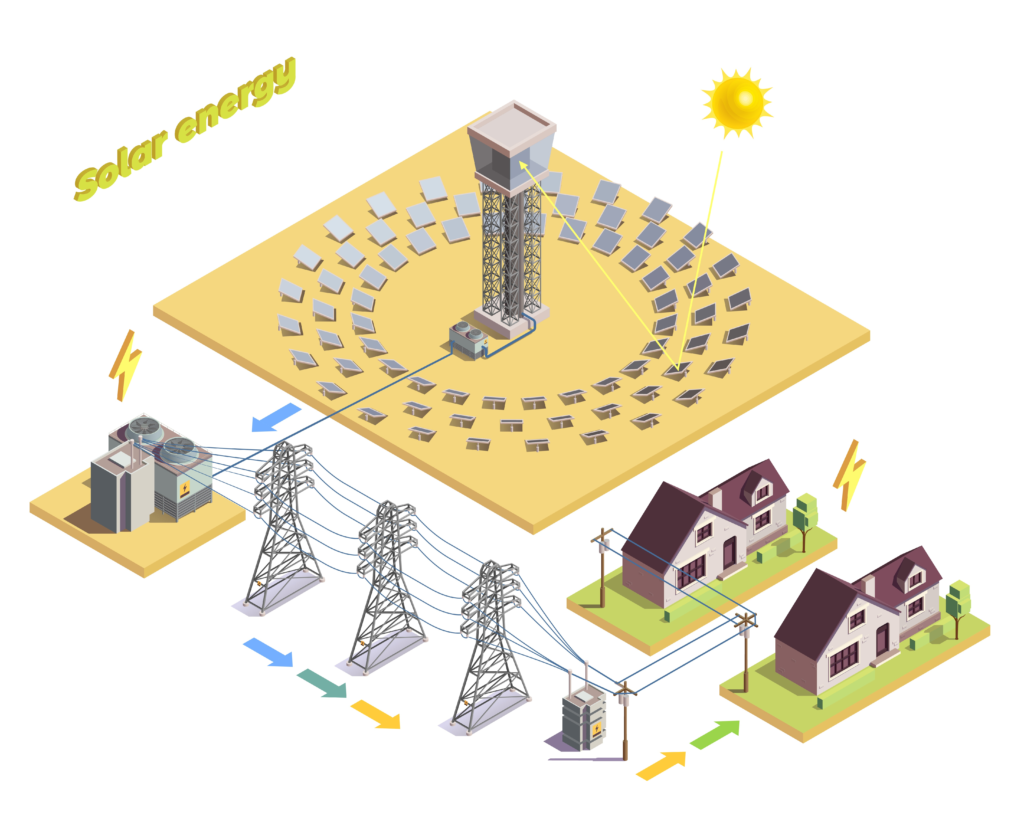
Some are also developing in Chile at present. Three solar tower power plants were built in the United States today. The solar power plant Ivanpah Dry Lake California is located 392 MW, Nevada is not in use today’s Crescent Solar Energy Project is located 110 MW and Mojave Desert, California, is the 5 MW Sierra Sun Tower, which has been shut down.
The solar energy is used in the tower for the heating of air to 700 degrees Celsius. The heat is collected in a boiler and used by a steam turbine to generate electricity. There are also towers that use water to distribute heat. More advanced systems which use nitrate salts due to higher heat transfer and storage characteristics in comparison with water and air are under investigation and testing. Thermal energy storage enables the device to generate electricity during cloudy weather or in the evening. These types of solar power plants are suitable for use in places where the weather is adverse. They are used for hailstorms and sandstorms in the Mojave Desert. California. Two of the plants constructed so far, however, have been found to be too costly to operate.
Solar Pond
Solar power plants use a saltwater pool which collects and stores thermal energy from the solar pool. It uses a methodology called the technology of salinity-gradient. This technique produces a thermal trap in the pond, in which energy can be either immediately used or retained for later use. This type of power station was used between 1984 and 1988 in Israel in the Beit Ha Arava power station. In Bhuj, India (no longer in service), and El Paso, Texas, other solar ponds were installed. Solar ponds absorb and store solar thermal energy by using a large body of saltwater.
Saltwater is of course a vertical salinity gradient with low salinity water on top and high salinity on the bottom, known as halocline. Salt levels rise with depth and thus density increases from the surface to the lake bottom, before solution at a given depth becomes uniform.
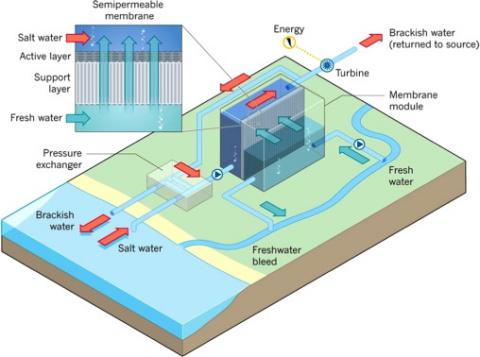
The theory is very straightforward. Solar rays are entering the pond and reaching the base of the pool finally. The water in a typical pond is heated, densified and raises a convection current at the bottom of the pond.
Solar ponds are built to prevent that by adding salt to the water until the lower levels are completely saturated. Since high-salinity water does not easily mix with low-salinity water, the convection currents are in every discreet layer and minimum mixing takes place. This method concentrates thermal energy and decreases the body’s heat loss. On average the water of high salinity can exceed 90°C and low salinity is approximately 30°C.
This humid, salty water is then supplied by a turbine or as a thermal energy source for electricity production. Solar energy isn’t just PV-panels, as you can see. Actually, the energy of the sun can be used and used for our good in many different ways.
Things to know about Solar Panels
Green energy is quickly gaining popularity, and solar is one of the most environmentally friendly choices for homeowners. The solar panel is a collection of solar cells that are electrically connected in a frame which turns sunlight into electricity. Switching to solar energy has a lot of benefits, which can save you money while improving the environment and can be linked to your house location and weather conditions. Let us go into more depth with ten fundamental data on solar panels.
1.There is no modern idea of using sun energy
Leonardo da Vinci in the 15th century was the first to predict it will become reality. In the 19th century, however, the first solar cell was built, but its solar power was 1%.
2.Completely free and clean Solar Energy
After you cover the initial cost of the solar panel, you would not have to spend a cent on the energy they generate. In addition, by using solar energy you can decrease your carbon footprint as it is completely green and sustainable.
Users of solar energy save up to 75 million barrels of oil and 35 million tons of carbon dioxide per year. In addition, a lot of power can be taken advantage of from the sun: the earth receives in just an hour more energy than in one year (approximately 120 terawatts). -facts-mid solar paneled
3.What’s their Fabric
Solar panels include solar cells made of semiconductors (such as silicone) that convert sunlight to electricity, also known as photovoltaic cells. If the cells are struck by light, the electrons are separated and pass through the cell to generate electricity. Solar cells in household installations can today turn about 20% of the sunlight they receive into electricity, whereas some business systems can achieve 40% of the so-called solar efficiency. Technologies progress quickly, however, and the performance of the solar system is expected to increase as prices decrease.
4.Two solar panels are available
Photovoltaic panels (Photovoltaic solar photovoltaic) transform sunlight into power and solar thermal panels heat water by absorbing warmth of the sun.
5.The cost of the original
There should be no overestimate of the costs to install solar panels and although the rates are high the payback period is reasonably short because of energy bills and government assistance savings. Homes with solar panels are selling faster and more expensive than without panels.
Advances in technology and rising installation numbers are expected to push prices down because of economies of scale and lower material costs. In reality, since the advent of solar panels, prices have declined continually: a kilowatt of solar power in 1977 would cost you up to $76.67. Now it costs $0.30 for this kilowatt.
6.Supervision
Nearly no maintenance of the solar panel is necessary once installed. You just have to ensure that they are clean, and that nothing shades them. A curved roof needs less maintenance because rain helps to remove soil. Solar panels often have an extremely long service life. You have a standard warranty of 25 years, but can last for 30 to 40 years.
7.Solar panels do not have to work with direct sunlight
Even though the sun is brilliant, maximum efficiency is achieved, electricity is still produced on cloudy days and in winter. In the night, however, electricity cannot be made, but this problem can be solved by a storage device. By selling over-energie to the national grid and making your electricity 100% independent, you can pay the solar battery storage costs. The fact that solar panels generate free energy, which is more costly and therefore worthwhile, should also be taken into account.
8.The possible problems
The form and inclinativity of the roof and the position of the house itself should be considered before installing solar panels. The roof should face south at a 30 degree angle in order to achieve the best annual results. These are not rigid criteria as solar panels also operate in various configurations as long as the system is shadow-free from 10am to 4pm. There are two reasons why panels should be kept far from covers and trees: they can shade the installations, and branches and leaves could scratch the surface and decrease their efficiency.
Excessive wind and rain exposure can also degrade long-term performance, and wind shelter should therefore be used in determining positioning. But solar panels have 25 years warranties, as previously stated, to ensure that the output during that time period should not be less than 80%. Moreover, oddly enough, in hotter climates, solar panels are no better. This is because solar cells use the sun and not the heat and decrease their efficiency by high temperatures.
9.The technology is multifaceted
Solar panels may be used for homes, highways, bridges as well as for satellites and spacecraft. Solar energy is entering every area of life: lightweight compact panels for your windows and small devices such as telephone charges are already present on solar blinds.
In addition, cars and boats of the next generation are being updated to solar. Increasingly, big, empty areas are hosting solar farms. The largest is in the California Mojave Desert, generating 90 percent of solar energy generated in the world.
10.Allowances
No planing permission is required to domestically install solar panels, as long as your facility does not exceed 200mm. Therefore, you would need approval if your device is too big or if it is installed within protected sites for other purposes.
Things to know about Solar-Rooftops
As we all know, Solar Energy is one of the clean energy sources that we already have. This technology is currently on the rise in the world, with the ever-growing threat of global warming. In order to make our planet and our environment a better and healthier place, renewable energies that have a minimum to no carbon base impact are important.
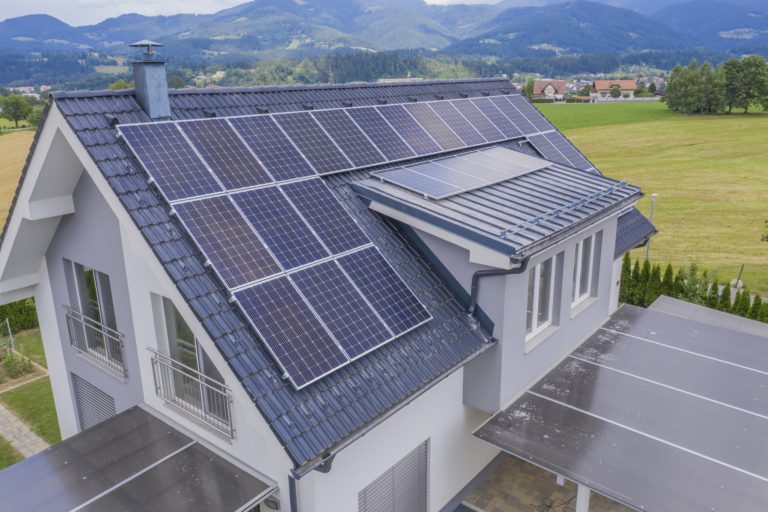
Solar panels produce power through the sun-emitting radiation. The roof top of a building is called photovoltaically systems. When solar panels are mounted on the top of a building. These systems are particularly useful for residential and commercial buildings of medium to large size.
All this should make us interested in the installation in our homes or other assets of solar rooftop systems.
3 solar rooftop types exist
- Monocrystalline – the cells of an ingot made of one big silicone crystal are sliced. In general, these panels are costlier and more space-effective.
- Polycrystalline – ingot cells consist of several small silicone crystals. Their cost is lower and the heat resistance is a little lower.
- A thin little solar cell. Amorphous. These tiny, thin layers of photovoltaic material consist of many layers.
Raw materials for the manufacture of solar panels
The solar panels are made of sand, silicone, ingots, wafers and ultimately solar cells.
- Silicon is present in a lot of sand, especially in natural beach sand. The most critical and important move is to turn sand into silicone.
- Ingots are molten compounds in cylindrical forms from silicon rocks. We receive wafers as ingots are cut into thin disks.
- Solar cells are made up from wafers covered with metal conductors that capture and transform solar rays and then combine solar cells to form matrix such as the structure known as solar panels.
Why is silicone the main raw material used for the manufacture of solar panels?
Silicon is one of the strongest heat conductors and the second most widely available material on Earth. The structure is spectral and captures a considerable quantity of radiation. It is now well studied and considered to be a reliable compound in the circuit industry.
No Contacted Pollutants
Solar panels don’t emit any harmful greenhouse gasses during energy production and do not use any portion that is not readily available – air or water but sunlight.
Time-Span
It takes about eight minutes for sunlight to come to earth and a few seconds for solar panels to come into touch. Solar rooftops won’t even make their clients wait hours for electricity to be produced.
Solar cell forms used in panels on the roof
In rooftop solar panels, there are two major types of solar cells.
- High-watt solar cells decrease the number of panel cells and minimize initial costs.
- Grid device cells are more used in urban areas and are less costly, which also makes the user indirectly becoming the power producer.
Production Capacity
1kWp of Panel in places with tremendous sunshine produces 1400 – 1600 Units per year, that is about 4% KWp per day. The average is over a year calculated. The generation of electricity at individual days depends on the location and changes in the environment.
Quality of Space
The installation of roof panels would require a shade free area and efficiency of the panel will be critical for defining the space necessary for installation of the panel. In relation to the area occupied by the panel, the efficiency of the panel can be measured. Low performance panels would require greater room and less space for the panel. With higher efficiency.
Solar Rooftop-Supported Equipment
The power generated by solar rooftops supports any electrical appliance that demands electricity. Air conditioners, cooling machines, TV, heaters, etc. The installations are designed for residential and industrial buildings.
Solar energy is one of the best ways to save the world and reduce power bills that wreak nerve. Not only will the installation of a solar panel reflect the human contribution to Planet Earth, it will also help our lives. People all over the world are moving to solar rooftops, and why do you need to know the above indicators?


